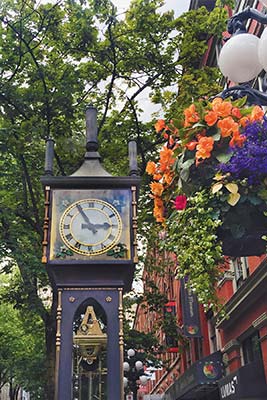
Gastown Steam Clock
How to enjoy Vancouver: Wander through the rainforest. Explore diverse cultures. Pair museum visits with hiking or kayaking, and check out the booming craft beer scene.
Explore the outdoors in Stanley Park downtown, in blooming botanical gardens, and at the North Shore peaks. For art and food, there’s Granville Island, home to galleries, breweries and distilleries, and the lively Public Market.
For cultural explorations, visit the stellar Museum of Anthropology and the Bill Reid Gallery of Northwest Coast Art, which illuminate the region’s aboriginal traditions. Dive deep into the city’s Asian culture at the Dr. Sun Yat-Sen Classical Chinese Garden or the Richmond Night Market.
There’s plenty for kids, too: a family-friendly science center, aquarium, and hands-on museums, ferries and gondolas, and forested trails. On Granville Island, youngsters even have their own Kids Market.

Gastown Steam Clock
Vancouver is compact enough that you can head for the North Shore, the University of British Columbia, Richmond, or other neighborhoods on the region’s extensive public transit system. You can walk or cycle through this green, waterfront city, too.
| Downtown and the West End | Map 1 |
Among Vancouver’s most famous downtown landmarks is Canada Place, its billowing white sails recalling a ship ready to set off to sea. Canada Place does have a seafaring function; the building, with its five 90-foot (27-meter) white sails made of Teflon-coated fiberglass, houses the city’s cruise ship terminal. Also inside are the east wing of the Vancouver Convention Centre, the Pan Pacific Hotel Vancouver, and several tourist attractions.
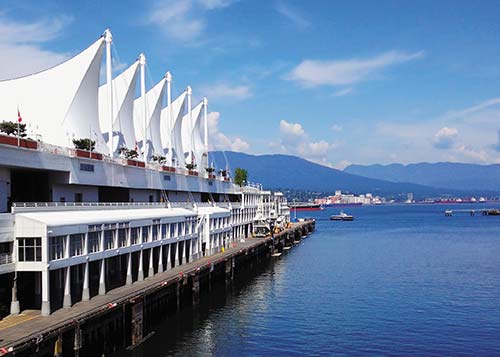
Canada Place
The coolest reason to visit Canada Place is FlyOver Canada (604/620-8455, www.flyovercanada.com; 10am-9pm daily, adults $27, seniors, students, and ages 13-18 $21, ages 12 and under $17), a multimedia simulated flight ride that has you swoop and soar across the country, flying over Arctic peaks, past Toronto’s CN Tower, and across the Canadian Rockies. You even feel the spray as you hover above Niagara Falls, and at one point, the northern lights spread out around you. The FlyOver Canada experience lasts about 30 minutes; the flight itself is just eight minutes long. Tickets are discounted if you buy them online in advance.
While you’re at Canada Place, follow the Canadian Trail, a walkway along the building’s west promenade. Check out interpretive panels about Canada’s ten provinces and three territories while enjoying the views of Stanley Park, Burrard Inlet, and the North Shore mountains. You’ll frequently see massive cruise ships at the docks from spring through fall.
MAP 1: 999 Canada Pl., 604/665-9000, www.canadaplace.ca
When Vancouver hosted the 2010 Winter Olympic Games, the candelabra-like Olympic Cauldron burned brightly. The 33-foot-tall (10-meter) landmark, comprising four diagonal columns leaning together, stands next to the Vancouver Convention Centre’s west building, near the Coal Harbour waterfront downtown—although it’s now lit only for special events.
MAP 1: Jack Poole Plaza, foot of Thurlow St.
Snaking along the waterfront on both sides of the downtown peninsula, extending around Stanley Park, through the West End and Yaletown, and along False Creek to Granville Island, Kitsilano Beach, and beyond, the Seawall is Vancouver’s most popular walking, running, and cycling path. The first sections of the Seawall were built in Stanley Park, beginning in 1917. Now, this 17.5-mile (28-kilometer) pathway, officially called the Seaside Greenway, may be the world’s longest uninterrupted waterfront path.
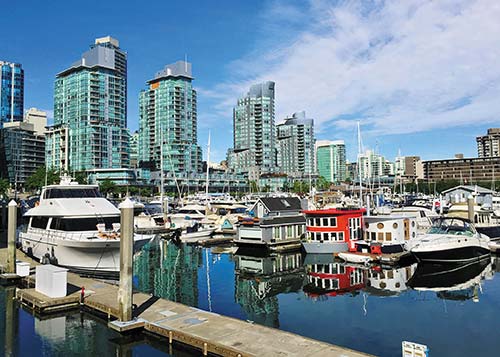
The Seawall follows the waterfront in downtown Vancouver.
The majority of the Seawall is paved, although in a few areas, it’s made of packed gravel. In most places, too, the Seawall is divided, with pedestrians routed to one side and cyclists, skaters, and anything with wheels on the other; watch for the signs to stay on the proper side, particularly when the pathway is busy.
MAP 1: On the waterfront from Canada Place to Stanley Park, English Bay, Yaletown, and along False Creek to Granville Island, Kitsilano, and the city’s west side
Ride the glass elevator to the top of this observation tower for views across the city, Stanley Park, the waterfront, and the North Shore mountains. Although many downtown buildings now dwarf this 30-story tower, which opened in 1977, it’s a good place to get oriented. Admission includes a 20-minute tour highlighting local sights as you circle the observation platform, which offers a 360-degree view. Even if you don’t follow a tour, you can ask the guides to point out particular locations and landmarks.
Lookout tickets are good all day, so you can check out the daytime views, then return to see the sunset or watch the evening lights twinkle.
MAP 1: 555 W. Hastings St., 604/689-0421, www.vancouverlookout.com; 8:30am-10:30pm daily May-Sept., 9am-9pm daily Oct.-Apr.; adults $18, seniors $15, students and ages 13-18 $13, ages 6-12 $10
The Bill Reid Gallery of Northwest Coast Art, which you enter through a courtyard in the Cathedral Place complex off Hornby Street, is dedicated to British Columbia artist Bill Reid’s life and work. Born to a Haida First Nations mother and a European father, Reid created more than 1,500 sculptures, carvings, and pieces of jewelry, most of which explore Haida traditions. Among the highlights on display are Reid’s Mythic Messengers, a 28-foot (8.5-meter) bronze frieze; more than 40 pieces of his gold and silver jewelry; and several of Reid’s works that the Canadian government featured on Canada’s $20 bill.
With exhibits both in its main high-ceilinged exhibition space and on an art deco-style mezzanine, the downtown gallery also showcases other First Nations art, including a full-size totem pole carved by James Hart of Haida Gwaii, and hosts changing exhibits of aboriginal art of the Northwest Coast region. Stop into the gift shop for First Nations prints, jewelry, and other artwork.
MAP 1: 639 Hornby St., 604/682-3455, www.billreidgallery.ca; 10am-5pm daily late May-early Sept., 11am-5pm Wed.-Sun. early Sept.-late May; adults $11, seniors and students $8, ages 13-17 $6
The permanent collection at the Vancouver Art Gallery includes more than 10,000 artworks, emphasizing artists from western Canada, including aboriginal artists, photographers, and artists with connections to the Pacific Rim region. The gallery has a particularly strong collection of works by British Columbia-born Emily Carr, one of Canada’s most important early-20th-century painters. Carr is known for her paintings of B.C.’s landscapes and its indigenous people.
Hosting changing exhibitions throughout the year, the gallery is housed in the former 1906 court building designed by architect Francis M. Rattenbury (who also designed Victoria’s Parliament Building). Noted B.C. modern architect Arthur Erickson incorporated the stone courthouse into the expanded gallery that was completed in 1983. Built around a grand rotunda, the art gallery has exhibit spaces on four levels.
The gallery offers guided tours (hours vary Thurs. and Sat.-Sun.; free with museum admission). The one-hour Survey Tours give an introduction to the current exhibits, while 30-minute Hot Spot tours focus on particular artworks. The gallery also runs programs for kids and families on Sunday afternoons that range from child-focused exhibit tours to hands-on art workshops.
The Vancouver Art Gallery has announced plans to relocate to a new building, designed by Herzog & de Meuron Architects, which will be constructed at West Georgia and Cambie Streets. Work on the new facility is slated to begin in 2017.
If you stand across Robson Street from the art gallery and look up toward the roof of the original courthouse building, you’ll spot two pieces of public art. One work is simply a line of text across the top of the building: Placed Upon the Horizon (Casting Shadows)—which is also the name of the piece, created in 1990 by American artist Lawrence Weiner.
The other, Four Boats Stranded: Red and Yellow, Black and White, by Vancouver-born artist Ken Lum, includes four fiberglass ships perched on the corners of the roof that represent the city’s history: a First Nations longboat (red); English explorer George Vancouver’s ship (white); the Komagata Maru, which carried Indian immigrants who were not allowed to disembark in Vancouver (black); and a cargo ship that brought migrants from China’s Fujian Province (yellow).
The peaceful Gallery Café (604/688-2233, www.thegallerycafe.ca) serves salads, panini, quiche, and wine on a shaded patio.
MAP 1: 750 Hornby St., 604/662-4719, www.vanartgallery.bc.ca; 10am-5pm Wed.-Mon., 10am-9pm Tues.; adults $24, seniors and students $18, ages 6-12 $6.50 (by donation 5pm-9pm Tues.)
The Vancouver Central Library is both an architectural landmark and a hub of information, art, and events. Designed by Israeli Canadian architect Moshe Safdie and opened in 1995, the building has a distinctive curved shape, modeled after Rome’s Colosseum. Before you even get to the books, you can have coffee or a snack in one of several cafés in the library’s light and airy interior atrium.
The library regularly hosts events, like lectures, author talks, and movie screenings, most of which are free. In front of the library, near the corner of Homer and Robson Streets, is a public art piece, The Words Don’t Fit The Picture, a neon sign by Vancouver artist Ron Terada.
MAP 1: 350 W. Georgia St., 604/331-3603, www.vpl.ca; 10am-9pm Mon.-Thurs., 10am-6pm Fri.-Sat., 11am-6pm Sun.; free
Vancouver wasn’t always the steel-and-glass city it is today. Go back to the Victorian era at the Roedde House Museum, in an 1893 Queen Anne revival-style home. Outfitted with period furnishings, the 11-room West End manor belonged to Gustav Roedde, the city’s first bookbinder, and his family. Admission includes a guided tour, where you learn about day-to-day life at the turn of the 19th century. The Sunday afternoon tour ($8) includes tea and cookies, and on the second Sunday of the month, you can stay for a classical concert (4pm; adults $15, seniors and students $12). There’s a jazz concert the second Thursday of the month (7pm; adults $15, seniors and students $12).
MAP 1: 1415 Barclay St., 604/684-7040, www.roeddehouse.org; 1pm-4pm Tues.-Fri. and Sun.; adults and ages 12 and over $5
One of Vancouver’s most popular public art pieces, A-maze-ing Laughter, by Beijing-based contemporary artist Yue Minjun, is composed of 14 larger-than-life bronze figures, with oversize grins dominating their equally oversized faces. Though the 8.5-foot-tall (2.6-meter) statues appear to be chortling hysterically, the artist has said that these smiling faces actually mask the misery of life in China’s post-Tiananmen Square era. The artwork faces English Bay in the West End.
MAP 1: Morton Park, Denman St. at Davie St.
| Gastown and Chinatown | Map 2 |
TOP EXPERIENCE
From the building tiles to the pathway pebbles, all the components of the Dr. Sun Yat-Sen Classical Chinese Garden came from China, as did the 52 master craftsmen who arrived from Suzhou in 1985 to construct the first authentic Ming Dynasty garden outside China. Named for the Chinese revolutionary leader and politician who is considered a father of modern China, the garden was built for the Expo ’86 world’s fair to promote understanding between Chinese and western cultures.
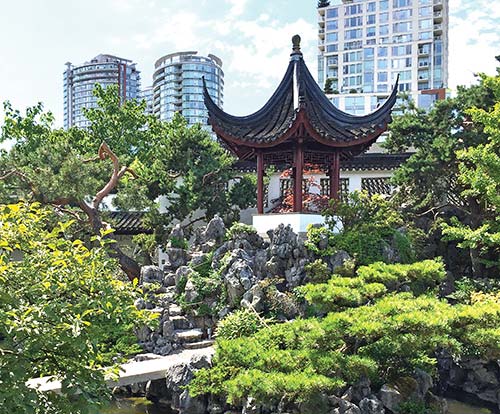
Dr. Sun Yat-Sen Classical Chinese Garden
The garden is compact, encompassing just one-third of an acre (1,200 square meters). As traditional Chinese garden design dictates, it’s built with a balance of four elements: rocks, water, plants, and architecture. The garden contains several pavilions, with elaborately scalloped roofs, lattice screens, and red columns; one of these structures, the Jade Water Pavilion, appears to float atop a pond. Wheelchair-accessible walkways meander between fish ponds and fountains, and around limestone outcroppings, bamboo groves, and native pine trees. The garden’s covered paths provide shelter on rainy days.
Take one of the informative 45-minute garden tours (included with admission) to learn more about the peaceful garden’s design and construction. From mid-June through August, tours start on the hour 10am to 4pm, with an additional tour at 5:30pm (tour times vary the rest of the year). After your tour, you’re free to wander the garden or simply linger in the serene setting.
Adjacent to the garden is the free city-run Dr. Sun Yat-Sen Park, which local architects Joe Wai and Donald Vaughan designed at the same time that the garden was constructed. While lacking the classical garden’s Chinese pedigree, this smaller park is still a pretty spot to sit. Head for the shaded pagoda and watch the fish swim past.
MAP 2: 578 Carrall St., 604/662-3207, www.vancouverchinesegarden.com; 10am-6pm daily May-mid-June and Sept., 9:30am-7pm daily mid-June-Aug., 10am-4:30pm daily Oct., 10am-4:30pm Tues.-Sun. Nov.-Apr.; adults $14, seniors $11, students and children age 6 and over $10
▪ Make an advance reservation to tour the large private art collection of the Rennie Collection at Wing Sang (click here).
▪ Linger over modern Canadian bites and a cocktail at Juniper Kitchen & Bar (click here).
▪ Stop into Juke for crispy, juicy fried chicken (click here).
▪ Browse the kitchenware at Ming Wo, which was established back in 1917 (click here).
Vancouver real estate marketer Bob Rennie has assembled one of Canada’s largest private collections of contemporary art. At the Rennie Collection at Wing Sang, a private museum in Chinatown’s oldest structure, the 1889 Wing Sang Building, you can see changing exhibitions of these works by both established and emerging international artists.
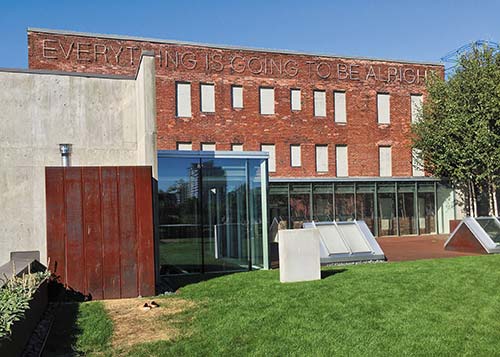
Rennie Collection at Wing Sang
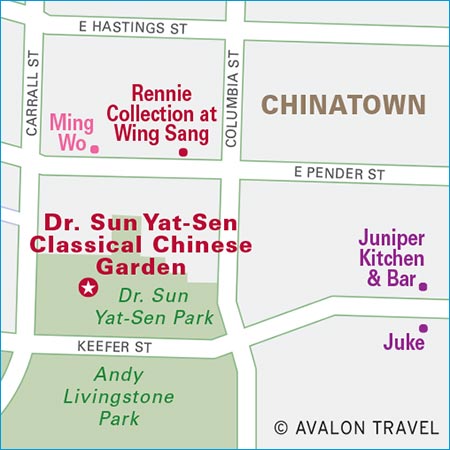
To visit, you must reserve a spot on a free 50-minute guided tour, offered several times a week, typically Wednesday, Thursday, and Saturday. Book in advance on the gallery website; the gallery doesn’t allow walk-in visitors.
The docents walk tour groups through the multilevel gallery’s current exhibit, introducing you to the artist and providing background both about the Rennie Collection’s holdings, which include works by approximately 200 artists, and about the building itself. Originally a two-story brick Victorian, the Wing Sang Building belonged to Chinese Canadian businessman Yip Sang. Sang expanded the building, adding a third floor in 1901, and in 1912, he constructed a six-story brick building across the alley, with an elevated passageway connecting the two structures. His family—three wives and 23 children—lived in this adjacent building.
Tours end in the rooftop sculpture garden, which has views across Chinatown. Installed on the building’s facade above the garden is British artist Martin Creed’s 2008 neon sculpture, Work No. 851: EVERYTHING IS GOING TO BE ALRIGHT. This string of text is illuminated at night, making it visible throughout the neighborhood. Rennie selected this work as a symbol of optimism for the future of Vancouver’s Chinatown.
MAP 2: 51 E. Pender St., 604/682-2088, www.renniecollection.org; by guided tour only, hours vary; free
Topped with three staggered gold roofs, the three-story Millennium Gate welcomes visitors to Vancouver’s Chinatown. Erected in 2002, this ornamental gateway spans Pender Street near the International Village mall, a half-block east of Abbott Street. The Chinese characters on the gate’s east side exhort visitors to “remember the past and look forward to the future.”
MAP 2: E. Pender St. at Taylor Way
If you’re curious about some of shiny Vancouver’s darker moments, plan a visit to the Vancouver Police Museum, where the exhibits about policing, criminology, and various misdeeds are housed in the 1932 former city morgue and autopsy facility.
The museum’s holdings include more than 20,000 artifacts, photos, and documents about crime and police work in the city, from the region’s early days to the present. In the Sins gallery, you can check out the collection of counterfeit money, illegal drugs, and weapons, all confiscated from criminals. The True Crime gallery exhibits photos and evidence from notorious regional crimes, many of which remain unsolved. You can also visit the autopsy suite, last used in 1980 but still looking ready for its next casualty, which has a collection of preserved human organs. Some people may find the graphic exhibits rather creepy; the museum may not be appropriate for younger children.
The museum runs two two-hour Sins of the City Walking Tours (May-Oct., adults $20, seniors, students, and ages 16-18 $16), where you can explore the underbelly of Gastown and Chinatown. The Red Light Rendezvous Tour tells you about the neighborhoods’ brothels and the women who ran them, while on the Vice, Dice, and Opium Pipes Tour, you walk the beat of a 1920s cop, on the lookout for gambling dens, bootlegging joints, and other nefarious activity. Check the museum website or phone for tour times. While kids are allowed in the police museum at their parents’ discretion, the minimum age for the walking tours is 16.
The Vancouver Police Museum is located east of Gastown, on the edge of Chinatown. Buses 4 and 7 from downtown stop nearby.
MAP 2: 240 E. Cordova St., 604/665-3346, www.vancouverpolicemuseum.ca; 9am-5pm Tues.-Sat.; adults $12, seniors and students $10, ages 6-18 $8
At Maple Tree Square is a statue of Gassy Jack, a fast-talking British sailor and riverboat pilot turned saloonkeeper, from whom Vancouver’s historic Gastown district got its name. In 1867, Captain John Deighton, nicknamed “Gassy Jack” for his habit of telling tall tales, promised local millworkers that he’d serve them drinks if they’d build him a saloon on the shores of Burrard Inlet. The motivated millworkers constructed the bar in just one day, and the fledgling Gastown neighborhood took its title from Deighton’s “Gassy” nickname. Artist Vern Simpson crafted the copper statue of the hat-wearing Deighton, who is standing atop a barrel. A gift to the city, the statue was installed in 1970.
MAP 2: Maple Tree Square, intersection of Alexander, Carrall, Water, and Powell Sts.
Sure, it’s touristy, but you’ll still find yourself in front of this local icon, waiting for it to toot its steam whistle every 15 minutes. The historic-looking Gastown Steam Clock actually dates back only to 1977, when area businesses commissioned clockmaker Ray Saunders to create the clock as part of the neighborhood’s revitalization. Saunders based his clock on an 1875 design; it draws power from the city’s underground steam heating system (and from three electric motors). Weighing over two tons, with steam whistles above its dial, the clock stands 16 feet (five meters) tall.
MAP 2: Water St., at Cambie St.
Charles Woodward started his career as a grocer in Ontario before opening a shop in Vancouver in the late 1800s. In 1903, he moved the original location of Woodward’s Department Store to Gastown. Woodward’s sold clothing for men, women, and children; housewares; and food. Growing to occupy most of a city block, the store developed into a prime Vancouver shopping destination. On its roof was a tower crowned with a red neon “W” that became a city landmark and is visible to this day.
In 1992, Woodward’s declared bankruptcy. It wasn’t until 2006 that the former store was converted into a mixed-use complex, combining residential, commercial, and arts spaces.
MAP 2: Hastings and Abbott Sts.
For cat lovers only: Vancouver’s first cat café is part coffee shop and part foster home for felines. Catfe, inside the International Village mall on the edge of Chinatown, has partnered with the B.C. SPCA, bringing in 8-12 adoptable cats every week. Visitors can pet and play with the animals while enjoying a coffee or light snack. The café allows only 16 guests at one time, for visits of up to one hour. In each time slot, 10 spots can be reserved online; book up to four weeks in advance on their website. The remaining spots are available for walk-ins.
MAP 2: International Village, 88 W. Pender St., #2035, 778/379-0060, www.catfe.ca; 11am-8pm Sun.-Wed., 5pm-9pm Thurs., 11am-9pm Fri.-Sat.; $5 with any café purchase, $8 without purchase
| Yaletown and False Creek | Map 3 |
What’s that dome thing? Kids may want to check out the distinctive geodesic dome (constructed for the Expo ’86 world’s fair) that houses Vancouver’s cool science museum, even before they venture inside. Clad in aluminum and illuminated at night with nearly 400 lights, the 155-foot-tall dome looks like a colossal shiny golf ball, shimmering on the edge of False Creek.
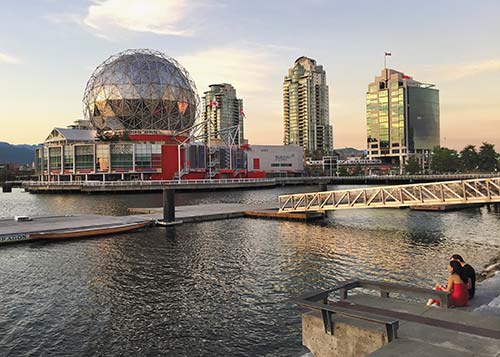
Science World, on Vancouver’s False Creek
Officially called Science World at Telus World of Science, the museum is full of hands-on exhibits about the human body, natural world, light and sound, puzzles and illusions, and more. The BodyWorks exhibit helps kids explore what’s inside of them and where they came from, while in the Eureka! Gallery they can walk on an oversize piano, try to capture their shadows, or launch a parachute. The littlest visitors have their own Kidspace, designed for children under age six, stocked with giant building blocks, water features, and games for exploring light and color. Live science shows and demonstrations take place throughout the day, entertaining (and educating) with fire, electricity, balloons, and other science themes—even grossology (“the impolite science of the human body”). A rotating selection of films plays on the five-story-tall screen in the immersive OMNIMAX Theatre ($6).
Outside in Ken Spencer Science Park, you can explore more interactive exhibits about the local environment and issues of sustainability. The park even has its own chicken coop.
MAP 3: 1455 Quebec St., 604/443-7440, www.scienceworld.ca, subway: Main Street-Science World; 10am-5pm Mon.-Fri., 10am-6pm Sat.-Sun. Apr.-late June, 10am-8pm Thurs., 10am-6pm Fri.-Wed. late June-early Sept., 10am-5pm Tues.-Fri., 10am-6pm Sat.-Sun. early Sept.-Mar.; adults $24, seniors and students $19, ages 3-12 $16
On the south side of False Creek, a new neighborhood developed thanks to the 2010 Winter Olympic Games. The residential buildings where athletes lived during the Games have been transformed into the Olympic Village, also known as the Village at False Creek, comprising stylish condominiums, brewpubs, cafés, a community center, and several public art pieces. Look for The Birds in the Southeast False Creek Plaza, two 18-foot-tall (5.5-meter) sparrows crafted by Vancouver artist Myfanwy MacLeod. The Olympic Village provides a great vantage point for skyline photos.
MAP 3: Bounded by Ontario St., Athletes Way, Columbia St., and W. 1st Ave.; subway: Olympic Village or Main Street-Science World
The odd-looking structure along False Creek that resembles a giant spaceship is B.C. Place, a sports and concert arena. Major League Soccer’s Vancouver Whitecaps (www.whitecapsfc.com) play here, as do the Canadian Football League’s B.C. Lions (www.bclions.com). Built in 1983, the arena has hosted the Expo ’86 opening ceremonies, the opening and closing ceremonies of the 2010 Olympic Games, the FIFA Women’s World Cup Canada 2015, as well as concerts by Michael Jackson, The Rolling Stones, Madonna, Paul McCartney, Taylor Swift, and many other performers.
Inside B.C. Place, the B.C. Sports Hall of Fame (Beatty St. at Robson St., Gate A, 604/687-5520, www.bcsportshalloffame.com; 10am-5pm daily; adults $15, seniors, students, and ages 6-17 $12) highlights regional sports history and offers interactive games where kids (and accompanying adults) can test their athletic prowess. Exhibits feature topics like Vancouver’s 2010 Winter Olympics, women and aboriginal sports figures, and a Hall of Champions showcasing B.C. athletes.
You can also book the All Access Experience ($20), which includes a B.C. Place tour along with access to the Hall of Fame. Tours visit the field, media room, premium boxes, and (when available) the locker rooms. The All Access Experience tours are offered on specific dates, so check ahead for availability.
If you’re attending an event at B.C. Place within two weeks of your visit to the Sports Hall of Fame, show your event ticket stub to get 50 percent off your Hall of Fame admission.
Outside the arena, near the intersection of Robson and Beatty Streets, is the Terry Fox Memorial, a series of four progressively larger sculptures by Vancouver artist Douglas Coupland. The memorial honors Fox, the B.C. man who embarked on a cross-Canada run in 1980 to raise money for cancer research after losing his own leg to the disease.
MAP 3: 777 Pacific Blvd., 604/669-2300, www.bcplacestadium.com; subway: Stadium-Chinatown
The Canadian Pacific Railway completed its cross-Canada train route in 1885, when rail workers drove the last spike of the transcontinental railroad into the ground at Craigellachie, near the town of Revelstoke, in eastern British Columbia. A year and a half later, on May 23, 1887, the first transcontinental passenger train rolled into Vancouver, pulled by Engine 374.
This historic locomotive is now on view at the Engine 374 Pavilion, next to the Yaletown-Roundhouse Community Centre. Posing next to the engine makes a fun photo op for rail enthusiasts of all ages.
The Engine 374 Pavilion is typically open every day, but hours vary, as the staff are all volunteers. Call to make sure they’re open before making a special trip.
MAP 3: 181 Roundhouse Mews, 604/713-1800, http://roundhouse.ca; subway: Yaletown-Roundhouse; hours vary; free
Vancouver’s first micro-distillery produces several varieties of gin and vodka in their 80-gallon (300-liter) copper-pot still. Long Table Distillery also makes small batches of seasonal spirits, like Akvavit or Amaro, so stop by their Yaletown tasting room to see what’s brewing. In the 28-seat space, with a polished wood bar and a wall of windows into the distilling room, you can choose a flight of three spirits ($6); the staff can explain what you’re drinking and how it’s made. They also host popular Gin & Tonic Fridays (4pm-9pm) and Cocktail Saturdays (3pm-9pm), when they offer custom cocktails, and you can purchase snacks from food trucks parked out front.
MAP 3: 1451 Hornby St., 604/266-0177, http://longtabledistillery.com; 1pm-6pm Wed.-Thurs., 1pm-9pm Fri.-Sat.
| Granville Island | Map 4 |
TOP EXPERIENCE
The island’s main attraction is the year-round indoor Granville Island Public Market. It’s a food lover’s heaven, where artistically arranged fruits garnish the produce stalls, and you can nibble away the day on charcuterie, cheeses, pastries, fudge, and other treats. While food vendors predominate among the nearly 50 stands, some stalls sell jewelry, leather goods, and other locally made crafts. There’s no particular order to the merchandise, though, so plan to wander, browse, and snack.
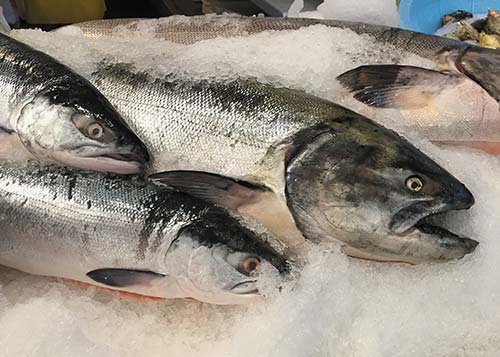
fresh fish, Granville Island Public Market
Granville Island was once known as “Industrial Island” for the sawmills, factories, and other businesses that operated here. The buildings that house the market were converted from their former industrial uses in the 1970s.
Start at Blue Parrot Espresso Bar (604/688-5127, www.blueparrotcoffee.com) for java with a water view. Sample the unexpectedly addictive salmon candy (cured, salty-sweet fish snacks) at any of the seafood counters, or line up with the locals for house-made charcuterie at Oyama Sausage (604/327-7407, www.oyamasausage.ca) or nut-studded grape loaves at Terra Breads Bakery Café (604/685-3102, www.terrabreads.com). You might hope that the kids won’t notice longtime favorite Lee’s Donuts (604/685-4021), at least until it’s time for dessert.
In summer, the Granville Island Farmers Market (10am-3pm Thurs. June-Sept.) sets up once a week in front of the Public Market, bringing more local farmers and artisans to the island. At any time, musicians and other entertainers might perform outside the market.
You can pick up picnic fixings or prepared foods in the Public Market and eat outdoors behind the market building. If it’s too crowded there, take your picnic to the opposite end of the island and enjoy it on the grass overlooking the water in Ron Basford Park.
For a behind-the-scenes look at the Public Market, book the two-hour Granville Island Market Tour with Vancouver Foodie Tours (http://foodietours.ca; 10:30am daily mid-May-mid-Sept., 10:30am Thurs.-Sun. mid-Sept.-mid-May; $54-58). You’ll learn the stories of many of the vendors and their products and sample 20 different foods and drinks.
The Public Market is located along False Creek, facing the downtown skyline. As you walk onto the island on Anderson Street, continue till the road forks, then bear left; the market will be one block ahead. The market is busiest on weekend afternoons, especially when the weather is nice.
MAP 4: 1689 Johnston St., 604/666-6655; http://granvilleisland.com; 9am-7pm daily; free
▪ Eat your way across the country at Edible Canada Bistro (click here).
▪ Check out the local music scene at the Backstage Lounge (click here).
▪ Browse museum-quality aboriginal art at Eagle Spirit Gallery (click here).
▪ Kayak around the island with Ecomarine Paddlesports Centre (click here).
▪ Find almost anything you’d wear on your head at the Granville Island Hat Shop (click here).
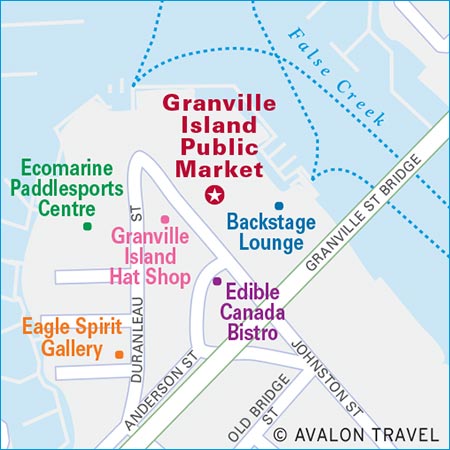
Explore this pedestrian-only cobblestone lane near the center of Granville Island for its artist studios and shops. Go inside the petite studios, where many of the artists welcome you to watch and chat while they work. Look for textile weavers, leather crafters, woodworkers, and even a sake maker in the lane’s low buildings.
MAP 4: Between Cartwright St. and Old Bridge St.
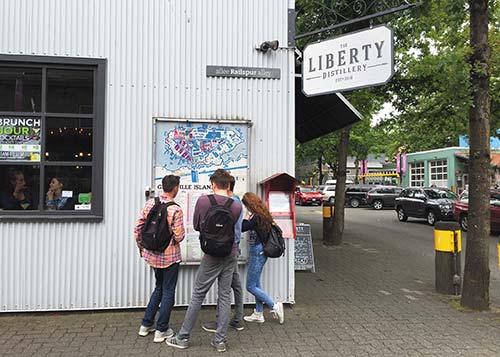
Granville Island’s Railspur Alley
Liberty Distilling brews small batches of vodka, gin, and whiskey in their 140- and 220-liter (36- and 58-gallon) copper-pot stills. Sample their handcrafted products in the cocktail lounge with its elaborately carved bar. Listen for the sound of a steam whistle announcing the start of happy hour (3pm-6pm Mon.-Thurs.). On weekends, Liberty offers a tour (11:30am and 1:30pm Sat.-Sun.; $10) of their facilities, where you can learn about the processes of mashing, fermenting, and distilling—with samples, of course. Tours are limited to 10 people, so make a reservation to ensure your spot.
MAP 4: 1494 Old Bridge St., 604/558-1998, www.thelibertydistillery.com; 11am-8pm daily
At the tiny shop that houses Artisan Sake Maker, Vancouver’s only local producer of Japanese rice wine, step up to the counter where the staff explain how sake is brewed. They offer tastings of a single sake ($2) or samples of three types ($5). In business since 2007, the company that Japan-born sake maker Masa Shiroki founded brews several varieties of sake, including sparkling sakes. Shiroki works with local farmers to grow the rice for his sakes here in British Columbia.
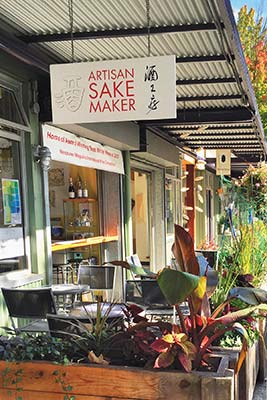
Learn how rice wine is brewed at the Artisan Sake Maker.
MAP 4: 1339 Railspur Alley, 604/685-7253, www.artisansakemaker.com; 11:30am-6pm daily
Sea Village is a community of colorful floating homes, each set on its own dock on False Creek. They’re private residences, but you can look at the area from the walkway above and imagine what it would be like to live here on the water. The entrance to Sea Village is off Johnston Street, just west of the Granville Island Hotel.
MAP 4: Off Johnston St., near intersection with Cartwright St.
On Granville Island, youngsters have their own marketplace, the multilevel Kids Market, a family-friendly minimall where two dozen cute shops sell toys, games, candy, and clothing. Note the children’s-only doorway at the entrance, then walk around to the back of the bright yellow building and notice the painted eyes looking down at you from a mural above. The kids can run around in the Adventure Zone, an indoor playground, or outside in the splash park (late May-early Sept.).
MAP 4: 1496 Cartwright St., 604/689-8447, www.kidsmarket.ca; 10am-6pm daily; free
Granville Island Brewing started producing craft beers back in 1984. They make a wide variety of beers, including their Island Lager and English Bay Pale Ale, but good choices to try at the brewery are the more limited small batch series, with brews like the Belgian-style Saison, Kellerbier Unfiltered, and West Coast Pale Ale.
Although most of their beer is now made in other locations, you can take the 30-minute tour (noon, 2pm, and 4pm daily; $10) of the original island brewery, which provides an education in beer making. The tour wraps up with five-ounce samples of three of their beers. You can also have a drink in their taproom, or pick up beer to go, along with brewery-themed merchandise, in their retail store (10am-8pm daily).
MAP 4: 1441 Cartwright St., 604/687-2739, www.gib.ca; noon-8pm daily
| Kitsilano | Map 5 |
Though its building resembles a flying saucer that might have landed in Kitsilano’s Vanier Park, this city museum’s unique structure, created by architect Gerald Hamilton, was actually designed to recall a traditional hat of the Haida First Nations people. Inside the Museum of Vancouver, the exhibition spaces are no less distinctive.
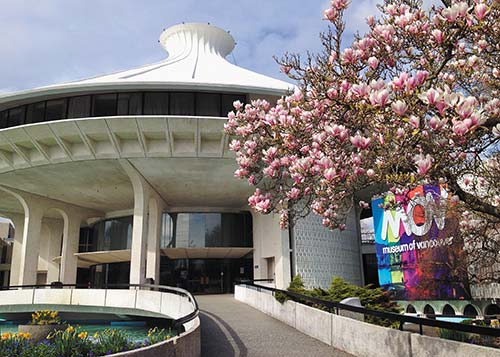
Museum of Vancouver
The permanent galleries take you through Vancouver’s past, from its aboriginal heritage to early settlement days to the hippie era of the 1960s, with participatory activities that bring the city’s history to life. Listen to recordings of First Nations people discussing their families, punch up some tunes on the 1950s jukebox, or dress for the Summer of Love in macramé. The sometimes-controversial temporary exhibitions explore social phenomena from happiness to sex. The museum hosts lectures, workshops, and social events that are as engaging as the exhibits themselves; check the calendar on their website for details.
The Vanier Park Explore Pass (adults $37, seniors, students, and ages 5-18 $30) includes admission to the Museum of Vancouver and the adjacent H. R. MacMillan Space Centre, as well as the nearby Vancouver Maritime Museum.
It’s a half-mile (0.9-kilometer) walk along the Seawall from Kitsilano Beach to the museum; from Granville Island, it’s just over a mile (1.8 kilometers) along the water and through Vanier Park. Either route is a lovely seaside stroll. To reach the museum by bus, take bus 2 from Burrard Street downtown into Kitsilano; get off at the corner of Cornwall Avenue and Chestnut Streets, where it’s a short walk toward the water to the museum. Or take False Creek Ferries (604/684-7781, www.granvilleislandferries.bc.ca) to Vanier Park from Granville Island or downtown.
MAP 5: 1100 Chestnut St., 604/736-4431, www.museumofvancouver.ca; 10am-5pm Sun.-Wed., 10am-8pm Thurs., 10am-9pm Fri.-Sat.; adults $18, seniors and students $15, ages 5-18 $8
In the same building as the Museum of Vancouver, the H. R. MacMillan Space Centre, the city’s planetarium, has galleries of space exhibits to explore and astronomy (and other space-themed) shows throughout the day. Presentations might let you experience “A Day in Space,” explore “Seven Wonders of the Universe,” or take a virtual expedition by “Surfing the Solar System.”
The Space Centre’s Gordon MacMillan Southam Observatory (604/738-2855; Fri.-Sat. early July-early Sept., Sat. only early Sept.-early July; adults $13, seniors and students $10, ages 5-11 $8) is also open for a planetarium show (7:30pm and 9pm) and guided stargazing (8pm-midnight) through the half-meter telescope. If you come only for the stargazing, admission is by donation.
MAP 5: 1100 Chestnut St., 604/738-7827, www.spacecentre.ca; 10am-5pm daily late June-early Sept., 10am-3pm Mon.-Fri., 10am-5pm Sat., noon-5pm Sun. early Sept.-late June, adults $18, seniors and ages 12-18 $15, ages 5-11 $13
Built in B.C. in the 1920s, the historic Arctic-exploring schooner St. Roch is now the centerpiece of the family-friendly Vancouver Maritime Museum, an A-frame building on the waterfront in Vanier Park. The St. Roch was the first to sail the Northwest Passage from west to east and the first to circumnavigate North America, when it traveled from Vancouver to Halifax via the Panama Canal in 1950.
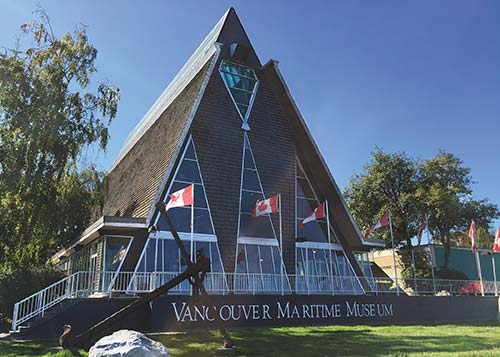
Vancouver Maritime Museum in Kitsilano
Climb aboard the St. Roch and learn more about its Arctic adventures. You can clamber around the wooden decks, explore the ship’s compact cabins, and even get behind the captain’s wheel, as you discover the boat’s story. The museum has other hands-on exhibits designed for kids, from piloting a submersible to talking with a model shipbuilder while he works, as well as changing exhibitions about the Pacific Northwest and Arctic maritime history.
Outside the museum is a 100-foot (30-meter) totem pole that Kwakwaka’wakw First Nations artist Mungo Martin carved to mark British Columbia’s centennial in 1958.
To get to the museum, take bus 2 from Burrard Street downtown to the corner of Cornwall Avenue and Chestnut Street in Kitsilano. Or take False Creek Ferries (604/684-7781, www.granvilleislandferries.bc.ca) to Vanier Park from Granville Island or downtown.
MAP 5: 1905 Ogden St., 604/257-8300, www.vancouvermaritimemuseum.com; 10am-5pm Fri.-Wed., 10am-8pm Thurs. late May-early Sept., 10am-5pm Tues.-Wed. and Fri.-Sat., 10am-8pm Thurs., noon-5pm Sun. early Sept.-late May; adults $11, seniors, students, and ages 6-18 $8.50 (by donation 5pm-8pm Thurs.)
| UBC and Point Grey | Map 5 |
TOP EXPERIENCE
To explore the culture of British Columbia’s aboriginal peoples and traditional cultures from around the world, don’t miss the striking Museum of Anthropology on the University of British Columbia campus, which houses one of the world’s top collections of Northwest Coast First Peoples’ art.
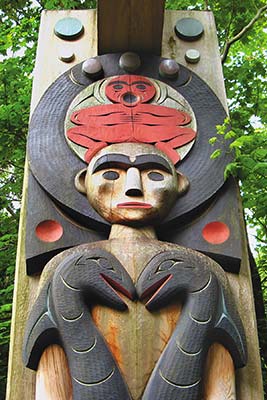
totem pole at the Museum of Anthropology
Canadian modernist architect Arthur Erickson, known for his innovative concrete and glass structures, designed the 80,000-square-foot (7,400-square-meter) museum, which opened in 1976. Inside, the Great Hall, with 50-foot-tall (15-meter) windows, provides a dramatic home for the immense totem poles, traditional canoes, and elaborate carvings. The museum also houses the world’s largest collection of works by noted Haida First Nations artist Bill Reid, including his massive cedar sculpture, The Raven and the First Men, which depicts a creation legend in which the Raven coaxes tiny humans out of a clamshell and into the world.
The museum’s Multiversity Galleries display thousands of objects from different cultures, along with audio, video, and photos that provide context and additional information about these materials and the communities they come from. The museum also mounts temporary exhibitions on world arts and culture, from contemporary Arab art to Peruvian silver and works by present-day indigenous artists.
Choose from several daily gallery tours, included with museum admission. There’s a 60-minute overview tour that walks you through the museum’s highlights (11am and 2pm daily, additional tour 6pm Thurs.), 30-minute “guide’s choice” tours that illustrate a particular theme or exhibit (1pm and 3:30pm daily), and tours of the temporary exhibits (check the website or call for schedules).
Behind the museum is an outdoor sculpture complex with memorial and mortuary totem poles, dating from the early 1950s to the present, as well as a Haida house that Bill Reid constructed.
To reach the museum by public transit, take any UBC-bound bus (including buses 4 or 14 from downtown) to the last stop at the UBC bus loop. From there, you can walk to the museum in 10-15 minutes, or transfer to shuttle bus C18, which stops in front of the museum. By car, it’s about 25 minutes from downtown to the museum, which has a public parking lot.
MAP 5: 6393 NW Marine Dr., 604/822-5087, http://moa.ubc.ca; 10am-9pm Thurs., 10am-5pm Fri.-Wed. mid-May-mid-Oct., 10am-9pm Thurs., 10am-5pm Fri.-Sun. and Tues.-Wed. mid-Oct.-mid-May; adults $18, seniors, students, and children $16 ($10 5pm-9pm Thurs.)
▪ Stroll among the flowers and koi ponds of the serene Nitobe Japanese Garden (click here).
▪ Explore the natural world, from a blue whale skeleton to tiny fossils, at the Beaty Biodiversity Museum (click here).
▪ Dine alongside UBC professors at Sage Bistro (click here).
▪ Check out the modern art collection at the Morris and Helen Belkin Art Gallery (click here).
You could be in Japan as you stroll among the flowers, waterfalls, and koi ponds at the serene Nitobe Japanese Garden, one of the most authentic traditional Japanese gardens in North America. Several stone lanterns decorate the paths; another feature is the Island of Eternity, a collection of rocks shaped like a turtle, which symbolizes longevity. Many of the plants, from azaleas and irises to maple and cherry trees, came from Japan. The garden is particularly scenic in April and May, when the cherry blossoms bloom.
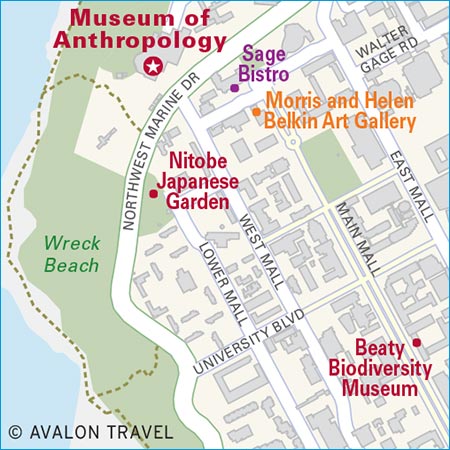
The 2.5-acre (one-hectare) garden is named for Dr. Inazo Nitobe, a professor, author, and advocate for East-West relations who served as Japan’s representative to the League of Nations in the 1920s. The garden’s 77-log bridge symbolizes Nitobe’s goal of being “a bridge over the Pacific.” The garden features five other bridges that crisscross its streams. For an extra fee, participate in a traditional Japanese tea ceremony (May-Sept., $10) in the garden’s teahouse, a classical structure in which you pass through exterior and interior gardens before entering the tearoom itself. Ceremonies are held on the last Saturday of the month on the hour from 11am to 3pm. Reservations are recommended; call 604/939-7749 to reserve.
The garden is a short walk from the Museum of Anthropology. From the UBC bus loop, you can walk or take shuttle bus C18.
MAP 5: 1895 Lower Mall, 604/822-6038, www.botanicalgarden.ubc.ca; 11am-5:30pm daily mid-Mar.-Oct.; 10am-2pm Mon.-Fri. Nov.-mid-Mar.; adults $7, seniors and students $5.50, ages 5-12 $4 (by donation Nov.-mid-Mar.)
An 85-foot (26-meter) blue whale skeleton, the largest on display in Canada, greets visitors to the Beaty Biodiversity Museum, a modern natural history gallery. The museum has more than two million specimens of bugs, fish, plants, fossils, and more, many of which come from B.C. and the surrounding regions. In this family-friendly museum, many of the items are set at kids’ eye level for youngsters to check out; in the interactive Discovery Lab, children can learn to use a microscope, compare different types of fossils, and participate in other hands-on activities.
At 10:30am most weekdays, a museum staffer leads a 30-minute hands-on presentation about specific specimens. The museum also offers 30-minute tours (11:30am and 3pm daily) highlighting particular aspects of the collections.
The museum is near the center of the UBC campus, a short walk from the UBC bus loop.
MAP 5: 2212 Main Mall, 604/827-4955, www.beatymuseum.ubc.ca; 10am-5pm Tues.-Sun.; adults $14, seniors, students, and children ages 13-17 $12, ages 5-12 $10
A garden of native B.C. plants, a woodland garden, a traditional Asian garden: These are just a few groupings of the more than 50,000 trees and plants that thrive at the 70-acre (28-hectare) UBC Botanical Garden, where walking paths wend through the woods and grounds.
Explore the B.C. Rainforest Garden, with its tall western red cedars, several varieties of maple trees, and bushes of blackberries, blueberries, and huckleberries. In the Alpine Garden, you can travel the world of mountain-region plants, grouped geographically, while in the Food Garden, you can check out vegetables, fruits, and herbs that grow locally. The David C. Lam Asian Garden blossoms with rhododendrons, magnolias, dogwood, hydrangeas, lilies, and other plants native to China, Korea, Japan, and the Himalayas that also thrive in Vancouver’s temperate climate. The garden’s two oldest trees, Douglas firs that are more 400 years old, are also in the Asian Garden.
The Botanical Garden is on the south side of the UBC campus. By public transit, take any UBC-bound bus (including buses 4 and 14 from downtown) to the last stop at the UBC bus loop; transfer to shuttle bus C20, which stops in front of the garden. By car, it’s about 25 minutes from downtown to the gardens, which have a public parking lot.
MAP 5: 6804 SW Marine Dr., 604/822-4208, www.botanicalgarden.ubc.ca; 9:30am-4:30pm daily; adults $9, seniors $7, ages 5-12 $5 (by donation Nov.-mid-Mar.)
An adventurous way to explore the UBC Botanical Garden is on the Greenheart TreeWalk, a 1,000-foot (310-meter) aerial trail system that takes you high into the rainforest canopy. Cross a series of swinging bridges to eight increasingly higher viewing platforms mounted among the Douglas firs, cedars, and other lofty trees. The tallest platform is 75 feet (23 meters) above the forest floor. To protect the trees, the platforms were constructed without using nails or bolts; a cable tension system suspends them from the tree trunks.
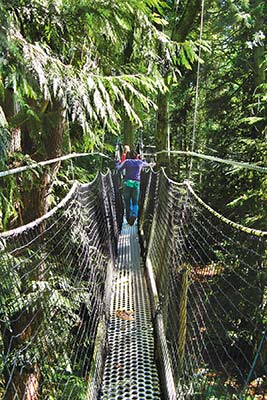
Greenheart TreeWalk
Explore the walkway on your own or on a 45-minute guided tour, included with your walkway ticket, where your guide tells you about the surrounding second-growth forest. Though the area was once logged, many trees are more than a century old. You’ll also learn how First Nations use various trees and plants, from carving canoes to traditional medicine. Each tour can accommodate up to 20 people.
The Greenheart TreeWalk is located within the UBC Botanical Garden. From the garden’s main entrance, follow the signs to the TreeWalk. Your TreeWalk ticket lets you explore the rest of the botanical gardens, too.
MAP 5: 6804 SW Marine Dr., 604/822-4208, www.botanicalgarden.ubc.ca; 10am-4:30pm daily Apr.-Oct.; adults $20, seniors $15, ages 5-12 $10; admission to UBC Botanical Garden included
The University of British Columbia operates a 60-acre (24-hectare) organic farm on the south side of the campus. You can purchase produce grown on-site at the weekly UBC Farm Market, held Saturday mornings on the farm grounds. The market also sells produce from other local growers, including indigenous farmers, plus baked goods, locally made honey, soaps, prepared foods, and crafts. The farm is a good place for kids, too, who can explore the fields and see what’s growing.
During the Saturday market, you can take a 30-minute family-friendly farm tour (11am Sat. June-Oct.; free). Reservations aren’t required for the farm tours; meet at the farm about five minutes in advance.
From the UBC bus loop in the center of campus, catch shuttle bus C18 or C20 to the farm. Get off on Ross Drive at Birney Avenue.
MAP 5: 3461 Ross Dr., 604/822-5092, http://ubcfarm.ubc.ca; 9am-1pm Sat. June-Oct.
| Cambie Corridor | Map 6 |
Wander the plant world without leaving Vancouver at the 55-acre (22-hectare) VanDusen Botanical Garden. With more than 250,000 plants from around the globe, the garden contains varieties native to the Pacific Northwest, other parts of Canada, and the Himalayas, the Mediterranean, and South America. Different flowers and plants are highlights at different times of year, like cherry trees and dogwood in the spring, roses and lilies in summer, colorful trees in the autumn, and evergreens in winter. You can find your way through an Elizabethan maze, too. A one-hour guided tour (10:30am and 2pm Wed., 2pm Thurs.-Tues. Apr.-mid-Oct., 1pm Sun. mid-Oct.-Mar.) helps you explore what’s growing.
From downtown, bus 17 for Oak Street stops at West 37th Avenue at the garden entrance.
MAP 6: 5251 Oak St., 604/257-8335, www.vandusengarden.org; 9am-8:30pm daily June-Aug., 10am-6pm daily Sept., 10am-5pm daily Oct. and Mar., 10am-4pm daily Nov. and Feb., 10am-3pm daily Dec.-Jan., 9am-7pm daily Apr., 9am-8pm daily May; adults $12, seniors and ages 13-18 $9, ages 3-12 $6 (discounted admission Oct.-Mar.)
At Queen Elizabeth Park, at the highest point in Vancouver, you can explore several gardens, have a picnic on its manicured grounds, or take photos of the city skyline and mountains.
In a geodesic dome near the center of the park, the Bloedel Conservatory (604/873-7000, www.vancouver.ca; 9am-8pm Mon.-Fri., 10am-8pm Sat.-Sun. May-early Sept., 10am-5pm daily early Sept.-Apr., adults $7, seniors and students $5, ages 3-12 $4) houses three different ecosystems, including a tropical rainforest, subtropical rainforest, and desert environment, with native plants and more than 200 free-flying birds. It’s a warm destination for a cold or rainy day. Also in the park are tennis courts, a pitch-and-putt golf course, and a lawn bowling field.
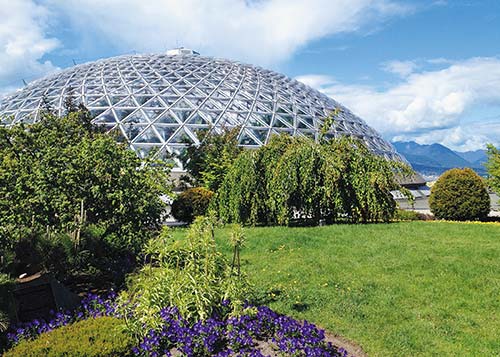
Bloedel Conservatory, Queen Elizabeth Park
To get to the park by public transit, take the Canada Line to King Edward station. Then either transfer to bus 15 southbound on Cambie Street to West 33rd Avenue, or walk south on Cambie Street to the park entrance. Follow the trails through the trees or walk along the park road to reach the conservatory; it’s a short but uphill climb.
MAP 6: 4600 Cambie St., www.vancouver.ca; dawn-dusk daily
| Commercial Drive | Map 7 |
The tasting room at Parallel 49 Brewing Company, one of the more established East Side breweries, is a beer tasting hall, a small-plates restaurant, and a spirited neighborhood gathering place. Three of the brewery’s founders grew up nearby in East Van. These days, the company is known for their Gypsy Tears Ruby Ale, the Tricycle Grapefruit Radler (blended from lager and red grapefruit juice), and a changing array of seasonal brews. Stop in for a tasting flight to see what’s on tap.
MAP 7: 1950 Triumph St., 604/558-2739, http://parallel49brewing.com; 11am-11pm daily
Billing themselves as “Canada’s first collaborative brewery,” Callister Brewing not only sells and serves their own beer in their East Side tasting room, but every year they also team up with three additional brewers who use the facilities in Callister’s red stucco brewery to make their own beers. Along with Callister’s own Resolution Dark Saison, Old Robyn English Strong, and 1 Hop Mind Pale Ale, you can sample these partners’ creations in the tasting room. Four-ounce samplers start at $2 each. The tasting room is teeny, with a long communal table and a few stools at the counter, so you’re likely to strike up a conversation with fellow beer aficionados.
MAP 7: 1338 Franklin St., 604/569-2739, www.callisterbrewing.com; 2pm-9pm Mon.-Thurs., 2pm-10pm Fri., 1pm-10pm Sat., 1pm-9pm Sun.
Family-run Doan’s Craft Brewing Company operates a tiny café-style tasting room and compact brewery in a converted East Side house, where local artist Ola Volo decorated one wall with an intricate black-and-white mural; her work appears on Doan’s labels, too. Try their Rye India Pale Ale or the German-style Kolsch. The 5.5-ounce samplers are $2. Because the petite space measures just 450 square feet (42 square meters), sitting and sipping at the communal table here feels like you’re relaxing in a friend’s living room.
MAP 7: 1830 Powell St., 604/559-0415, http://doanscraftbrewing.com; 2pm-9pm Mon.-Thurs., 2pm-11pm Fri., noon-11pm Sat., noon-9pm Sun.
A husband and wife team manages Powell Street Craft Brewery in a small East Side warehouse on busy Powell Street. Old Jalopy Pale Ale and Ode to Citra (also a pale ale) are two of their well-regarded brews. Try a glass or a flight in their tasting room, where you can perch at a blond-wood bar-height table and look through the window into the brewery. Glasses start at $1.75 for a five-ounce sampler; a flight of four is $6.10.
MAP 7: 1357 Powell St., 604/558-2537, www.powellbeer.com; 2pm-8pm Mon., 2pm-9pm Tues.-Thurs., noon-10pm Fri.-Sat., noon-8pm Sun.
Standing out amid the East Side beer makers, Odd Society Spirits is a small batch distillery housed in a former motorcycle garage, where they make their signature East Van Vodka, along with gin and a “moonshine” whiskey. Tasting flights (three samples for $7) and mixed drinks are available in their front room, an old-time cocktail lounge with marble-top tables and a long bar. In the lounge, floor-to-ceiling windows showcase the distilling room in back, which you can visit if you drop in on weekend afternoons for a free distillery tour. On these informal visits, you’ll learn about the distilling process and how they use their two 92-gallon (350-liter) German-made copper-pot stills and their 15-foot (4.5-meter) “vodka column,” which removes impurities from the vodka.
MAP 7: 1725 Powell St., 604/559-6745, www.oddsocietyspirits.com; 1pm-10pm Thurs., 1pm-11pm Fri.-Sat., 1pm-6pm Sun.; tours 4pm Sat.-Sun.
This illuminated cross with the words “EAST VAN” nested inside isn’t a religious symbol. Rather, it’s a public art piece, Monument for East Vancouver, created by Vancouver-born artist Ken Lum.
Lum has written that the inspiration for the 57-foot (17-meter) sculpture, which lights up after dark, came from a graffiti symbol that circulated throughout the city’s East Side as early as the 1940s. Its origin is unknown, although Lum notes that it may derive from the large Catholic community that lived in the area at that time, when many Italian, Greek, and Eastern European immigrants settled in East Van.
East Vancouver was once considered the poorer cousin to the city’s well-to-do West Side neighborhoods. As real estate prices have escalated across the region, however, East Van has lost some of its working-class image, but Lum’s artwork has become a symbol of local pride for many East Siders. Look for images of this “monument” on T-shirts around town.
MAP 7: Intersection of Clark Dr. and E. 6th Ave.
| Richmond | Map 8 |
From spring through fall, Richmond’s two weekend night markets are packed with visitors enjoying the Asian food stalls, quirky shopping opportunities, and general carnival atmosphere. Visiting these outdoor Richmond events is like traveling to a night market or festival in Asia, but without the jet lag.
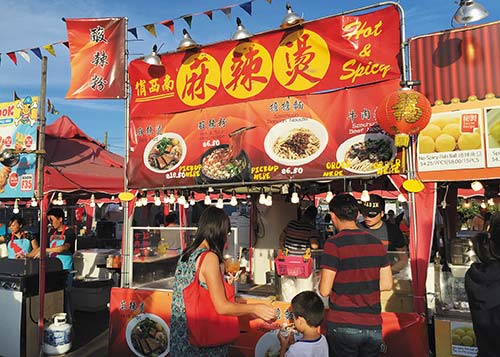
Richmond Night Market
Don’t have dinner before you go, since there’s plenty to sample: grilled kebabs, squid on a stick, bubble waffles, handmade tofu pudding, and many other Asian-style snacks; most dishes cost $5 or less. Vendors also sell inexpensive cell phone cases, socks, electronic gadgets, and more.
The largest night market in North America, drawing thousands of visitors every weekend, the Richmond Night Market has nearly 300 vendors, including row upon row of snack sellers offering up all manner of Asian savories and sweets. During the evening, the aisles between the outdoor booths, set up in a vast parking lot, get increasingly jammed with hungry patrons looking for their next bite; most dishes are small and easy to share. The market has some tables and benches, but many visitors eat on the go, as they wend through the market aisles or try to find an uncrowded corner to stand.
Lines at the entrance gate can be lengthy. If you’re visiting with a group, or if you plan to visit more than once, purchase a $20 pass that includes seven admissions. You can use them all at once or at any time during the season. Passholders enter through a separate gate that bypasses the main queue.
The Richmond Night Market is the easiest of the two Vancouver-area night markets to reach by public transit. Take the Canada Line from downtown to Bridgeport Station. From there, it’s a 15-minute walk to the market. Just follow the crowds.
MAP 8: 8351 River Rd., 604/244-8448, www.richmondnightmarket.com; 7pm-midnight Fri.-Sat., 7pm-11pm Sun. mid-May-mid-Oct.; adults $3.75, seniors and kids under 10 free
Richmond’s second night market, the International Summer Night Market, has a similar lively mix of food stalls and other vendors. With about 60 outdoor booths, both food vendors and other retailers, it’s smaller than the always-packed Richmond Night Market, which can make it a little less overwhelming and more family-friendly. The market also hosts a nightly light show.
Take the Canada Line from downtown to Bridgeport Station, where you can catch a free shuttle to the market, which is located in a parking lot behind the Home Depot.
MAP 8: 12631 Vulcan Way, 604/278-8000, www.summernightmarket.com; 7pm-midnight Fri.-Sun. May-mid-Sept.
The Richmond branch of the Canada Line follows No. 3 Road through the district known as the Golden Village, the region’s new Chinatown. You’ll know you’ve arrived when the Chinese-language signs outnumber those in English, and Asian restaurants, markets, and shops line the strip malls and surrounding streets.
A good place to start exploring is Aberdeen Centre, a glitzy Hong Kong-style shopping mall, with shops selling tea, electronics, clothing, Asian-language books, and more. Hunt for all kinds of quirky (but useful) housewares and gadgets at Daiso (604/295-6601, www.daisocanada.com; 9:30am-9pm daily), the local branch of a Japanese discount chain; at the Richmond location, most products cost just $2. On the mall’s third floor, stop for excellent Cantonese, Sichuanese, Taiwanese, Japanese, and Korean fare in the busy food court.
Aberdeen Centre has several good sit-down restaurants, too, including Fisherman’s Terrace Seafood Restaurant (604/303-9739; dim sum 10am-3pm daily, dinner 5:30pm-10pm daily; dim sum $4-15, mains $15-35) for dim sum, Chef Hung Taiwanese Beef Noodle (604/295-9357, www.chefhungnoodle.com; 11am-9pm Sun.-Thurs., 11am-9:30pm Fri.-Sat.; $8-13) for Taiwanese noodle soup, and Guu Richmond (604/295-6612, www.guu-izakaya.com; 11:30am-4pm and 5pm-9pm Mon.-Thurs., 11:30am-4pm and 5pm-8pm Fri.-Sat.; $5-13), a branch of Vancouver’s popular Japanese izakaya minichain.
Aberdeen Centre is one block from the Canada Line’s Aberdeen Station, at the corner of Cambie Road and Hazelbridge Way.
MAP 8: Aberdeen Centre, 4151 Hazelbridge Way, 604/270-1234, www.aberdeencentre.com; 11am-7pm Sun.-Wed., 11am-9pm Thurs.-Sat.
Want to swish down an Olympic bobsled track, pilot a race car, or test your mettle on a ski jump? At the Richmond Olympic Experience, aka “The ROX,” an interactive Olympic sports museum, you can try out simulators of several Olympic and Paralympic events. Among the activities, which are best suited for older kids and adults, there are games to test your reaction time and see how high you can jump; you can also pretend to be a sports broadcaster reporting on the Olympic Games. For Olympic trivia buffs, the multimedia exhibits have thousands of facts about the Games through the decades. Actual Olympic medals and torches are on display, too.
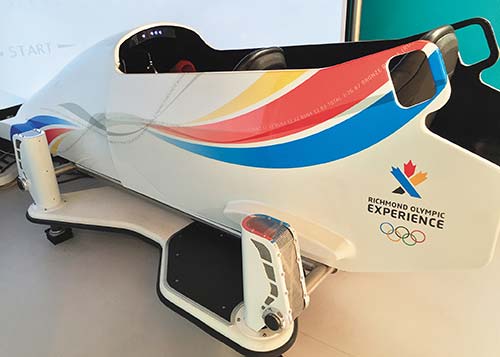
Slide down a virtual Olympic bobsled track at the Richmond Olympic Experience.
The ROX is located inside the Richmond Olympic Oval, a sports facility that was a venue for the 2010 Winter Olympic Games. Most exhibits are on the third floor. On the main level, you can watch an eight-minute film about pursuing Olympic dreams. Stop on the second floor to see another small exhibition space that includes Athlete, a fascinating photograph by Howard Schatz that portrays the “ideal” male and female body types for a wide variety of sports: a jockey next to a sumo wrestler next to a football player, a boxer next to a gymnast next to a shot-putter, and many more.
To reach The ROX by public transit from Vancouver, take the Canada Line (Richmond branch) to Richmond-Brighouse Station. Change to bus C94, which stops directly in front of the Richmond Olympic Oval. The C94 currently runs only every 35 minutes and there’s no service on Sunday, so check the schedule online (www.translink.ca) before you set out.
You can also walk along a riverfront path to The ROX from the Canada Line’s Aberdeen Station. After exiting the station, walk one block west on Cambie Road to River Road. Turn left (south) onto the path that hugs the Fraser River. From here, it’s 1.25 miles (two kilometers) to the Olympic Experience.
MAP 8: 6111 River Rd., Richmond, 778/296-1400, http://therox.ca; 10am-5pm Tues.-Sun.; adults $17, seniors and ages 13-18 $13, ages 6-12 $11
| The North Shore | Map 9 |
TOP EXPERIENCE
Open for wildlife adventures, walks in the woods, and many other activities from spring through fall, and for skiing and snowboarding in winter, Grouse Mountain lets you experience the mountains less than 40 minutes from downtown. On a clear day in any season, you can look out over the peaks and across the Burrard Inlet to the city skyline.
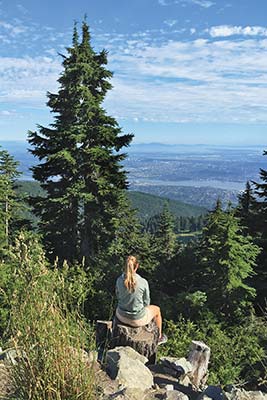
Grouse Mountain views
Take the Skyride (8:45am-10pm Mon.-Fri, 8:15am-10pm Sat.-Sun.), North America’s largest tram system, to the Peak Chalet, where you can watch a film about the region’s wildlife at the Theatre in the Sky or take in the corny but entertaining 45-minute Lumberjack Show (noon, 2:30pm, and 4:30pm daily late May-mid-Oct.), complete with log rolling, tree climbing, and ax throwing. The Birds in Motion demonstration (1:30pm, 3:30pm, and 5:30pm daily late May-late Sept.) shows off the skills of eagles, falcons, and other birds of prey, while at the Grouse Mountain Refuge for Endangered Wildlife you can learn more about bears, wolves, owls, and other creatures.
Several self-guided walking trails through the evergreen forests start near the Peak Chalet, or you can take a 45-minute guided eco-walk (late May-Sept.) that departs several times a day to learn more about local geology, animals, and plants.
The basic access tickets, called the Alpine Experience (adults $45, seniors $41, ages 13-18 $26, ages 5-12 $16), are available year-round and give you access to the Skyride, Theatre in the Sky, Lumberjack Show, Birds in Motion, wildlife refuge, and walking trails. To go higher up on the mountain, where the views are even more expansive, purchase a Peak Experience ticket (late May-Oct., adults $49, seniors $45, ages 13-18 $30, ages 5-12 $16), which adds a ride on the Peak Chairlift. The Ultimate Experience (late May-mid-Oct., adults $59, seniors $55, ages 13-18 $40, ages 5-12 $16) includes a visit to The Eye of the Wind, a mountaintop wind turbine. Separate lift tickets are required for skiing and snowboarding.
To incorporate more adventures into your Grouse visit, go zip-lining across the peaks ($75-115, including a Peak Experience ticket) or try paragliding (late June-Sept., $229, includes Peak Experience ticket if booked in advance). Early risers can have breakfast with the bears (8:30am Sat.-Sun. late Mar.-late June and mid-Sept.-mid-Oct., 8:30am daily late June-mid-Sept., adults $65, seniors $60, ages 13-18 $45, ages 5-12 $35, includes Alpine Experience ticket) at the wildlife refuge, a popular activity for families.
Looking for a challenge? An alternative to riding the Skyride to the Peak Chalet is to hike the Grouse Grind, a 1.8-mile (2.9-kilometer) trek up a forested mountain staircase, where you gain an elevation of 2,800 feet (850 meters). The trail isn’t technically difficult, but you’re climbing 2,830 steps, so it’s a workout. Hikers are allowed to walk uphill only and return to the parking area on the Skyride (one-way $10).
In winter, Grouse Mountain has 26 runs for downhill skiing and snowboarding, 14 of which are open at night (you can buy night tickets that are valid 4pm-10pm). It’s the only North Shore ski destination that’s easily accessible by public transportation. While many of the trails are relatively gentle, more advanced skiers should head for the Blueberry Bowl, where you can access more challenging runs from the Olympic Express and Peak Chairs. If you’ve arrived in Vancouver without proper winter clothes, you can rent jackets, snow pants, helmets, and gloves, as well as ski and snowboard gear. Lift tickets (full-day/night adults $61/48, seniors ages 13-18 $45/40, ages 5-12 $25/22, ages 0-4 free) include access to the Alpine Experience activities along with the ski and snowboard runs.
Other winter activities include snowshoeing on four groomed trails or ice-skating on the mountaintop rink. For these activities, if you’re not already buying a lift ticket to ski or snowboard, you need to purchase an Alpine Experience Pass.
The mountain’s fine dining restaurant, The Observatory (604/998-5045, www.observatoryrestaurant.ca; 5pm-10pm daily), in the Peak Chalet, serves seafood, steak, and other west coast fare. Make your dinner reservation in advance to obtain a complimentary Alpine Experience ticket for each member of your party. There are several casual eateries and snack shops on the mountain as well.
You don’t need a car to get to Grouse Mountain. From May through early October, a free shuttle departs from Canada Place every 30 minutes from 9am to 5:30pm (no 2pm departure) and returns from the mountain every 30 minutes from 9:30am to 6:30pm (no 1:30pm departure). Year-round, you can take public transit between downtown and Grouse; take the SeaBus from Waterfront Station to Lonsdale Quay and change to bus 236 for Grouse Mountain, which will drop you at the mountain’s base.
MAP 9: 6400 Nancy Greene Way, North Vancouver, 604/980-9311, www.grousemountain.com; 9am-10pm daily
▪ Get your thrills swaying high above the ground on the Capilano Suspension Bridge (click here).
▪ Work up a sweat by hiking up The Grouse Grind, known as “Mother Nature’s stairmaster” (click here).
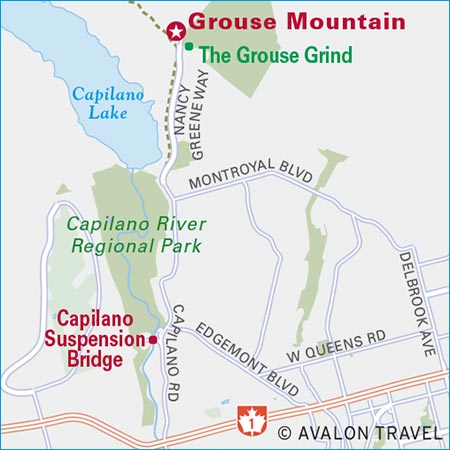
Built in 1889, the 450-foot (137-meter) Capilano Suspension Bridge sways 230 feet (70 meters) above the Capilano River in a rainforest park. And yes, it does swing!
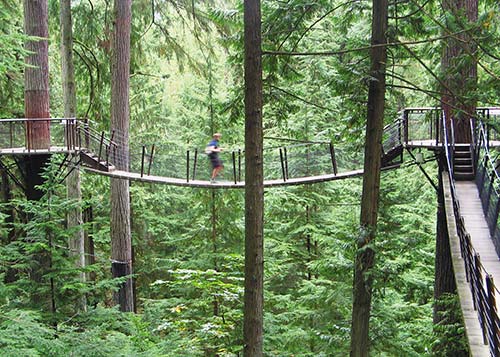
treetop trekking at the Capilano Suspension Bridge
Before you cross the bridge, follow the Cliffwalk, a series of boardwalks and stairways cantilevered out over the river. If you’re feeling brave, stand on the glass platform and look down (way down!) into the canyon where the river rushes below.
After you’ve made your way over the suspension bridge, explore the Treetops Adventure, a 700-foot (213-meter) network of gently swaying wooden bridges linking eight treehouse platforms. Many of the surrounding Douglas firs are up to 300 feet (90 meters) tall. Back on the ground, gentle walking trails lead through the rainforest.
Particularly in the summer high season, the least crowded times to visit the bridge are before 11am or after 3pm. Take a free shuttle to the suspension bridge from several locations downtown. Call or check the website for seasonal schedules. By public transportation, take the SeaBus from Waterfront Station to Lonsdale Quay and change to bus 236 for Grouse Mountain. Get off at Ridgewood Avenue, a block from the bridge park.
MAP 9: 3735 Capilano Rd., 604/985-7474, www.capbridge.com; 8:30am-8pm daily late May-early Sept., 9am-6pm daily early Sept.-mid-Oct., 9am-5pm daily mid-Oct.-late Nov., 11am-9pm daily late Nov.-early Jan., 9am-5pm daily early Jan.-mid-Mar., 9am-6pm daily mid-Mar.-late Apr., 9am-7pm daily late Apr.-late May; adults $40, seniors $37, students $33, ages 13-16 $27, ages 6-12 $14
The 617-acre (250-hectare) Lynn Canyon Park is a little farther from downtown than the Capilano bridge, but it has its own suspension bridge built back in 1912—and it’s free.
Hiking trails wend through the park, including the 30 Foot Pool Trail and the Twin Falls Trail, which both lead to popular swimming areas (bring your bathing suit); both trails are easy and are 0.6 mile (1 kilometer) long, starting from the suspension bridge. The Ecology Centre (3663 Park Rd., North Vancouver, 604/990-3755, www.lynncanyonecologycentre.ca, 10am-5pm daily June-Sept., 10am-5pm Mon.-Fri., noon-4pm Sat. Sun. Oct.-May, donation $2) has kid-friendly exhibits about the region’s plants and animals.
To get to the park by public transit, take the SeaBus from Waterfront Station to Lonsdale Quay, then change to bus 228 for Lynn Valley. The bus will drop you off about a 15-minute walk from the park entrance.
MAP 9: Park Rd., North Vancouver, www.lynncanyon.ca; 7am-9pm daily summer, 7am-7pm daily spring and fall, 7am-6pm daily winter; free
A food and shopping complex overlooking the water adjacent to the SeaBus terminal in North Vancouver, Lonsdale Quay is like a small-scale Granville Island Public Market. Vendors sell fruit, vegetables, seafood, sandwiches, and other prepared foods. Green Leaf Brewing (604/984-8409, www.greenleafbrew.com) makes craft beer; the Artisan Wine Shop (604/264-4008, www.artisanwineshop.ca) does complimentary wine-tastings.
A new contemporary art museum, the Polygon Gallery, is slated to open in November 2017 on the waterfront at the foot of Lonsdale Street, just east of Lonsdale Quay. It will be the new home for Presentation House Gallery (604/986-1351, http://presentationhousegallery.org), which has exhibited works by Vancouver and international photographers over the past 30 years.
The easiest way to get to Lonsdale Quay from downtown Vancouver is to take the SeaBus from Waterfront Station, a 12-minute ride.
MAP 9: 123 Carrie Cates Court, North Vancouver, 604/985-6261, www.lonsdalequay.com; 9am-7pm daily
The seaside village of Horseshoe Bay, 12.5 miles (20 kilometers) northwest of downtown Vancouver, is a departure point for BC Ferries’ routes to Bowen Island, Nanaimo (on Vancouver Island), and the Sunshine Coast. It’s a pretty spot for a picnic by the shore or for a quick break when you’re driving between Vancouver and Whistler.
Another reason to visit Horseshoe Bay is to take a two-hour Sea Safari from Sewall’s Marina (6409 Bay St., West Vancouver, 604/921-3474, www.sewellsmarina.com; 11am, 1:30pm, and 4pm Apr.-Oct.; adults $87, seniors and ages 13-18 $77, ages 5-12 $57). These scenic guided wildlife cruises in 30-foot (10-meter) Zodiac-style boats take you through the waters of Howe Sound, where you’ll spot seals and a variety of seabirds. The company offers a shuttle ($18 pp round-trip) from downtown Vancouver hotels.
By public transit from downtown Vancouver to Horseshoe Bay, catch bus 257 (Vancouver/Horseshoe Bay Express), along West Georgia Street, which takes you to the Horseshoe Bay Ferry Terminal in 45 minutes. The ferry terminal is in the village.
You can generally make the drive from downtown to Horseshoe Bay in 30-35 minutes. Allow extra time if you’re catching a ferry, since traffic congestion can cause delays. Returning to the city can take longer, too, since traffic often backs up on the West Vancouver side of the Lions Gate Bridge entrance.
MAP 9: Off Highway 1 West, West Vancouver